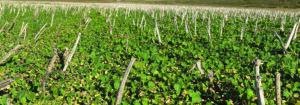Quest to turn off secondary dormancy
KEY RESULT:
Secondary dormancy is like a deep sleep for seeds, extending their life in the soil and increasing their weedy nature. Canola tends to have strong secondary dormancy, which is why volunteer canola can often germinate years after harvest. The goal is to find the genes responsible, and breed them out or turn them off.
PROJECT TITLE, PRINCIPAL INVESTIGATORS:
Weeding out secondary dormancy potential from volunteer canola,” Sally Vail, Agriculture and Agri-Food Canada Saskatoon, and Rob Gulden, University of Manitoba
FUNDING:
AgriScience Program (Canola Cluster) under the Canadian Agricultural Partnership
PUBLISHED ARTICLES:
Read the full report on the Canola Research Hub.
Volunteer canola is becoming an ever-increasing problem and a concern in rotational crops and in-crop across the Canadian Prairies. The underlying mechanism contributing to increased volunteers in weed seed banks is secondary dormancy. This is a heritable trait that could potentially be selected against in breeding programs using marker assisted selection. Molecular tools could also be useful in monitoring and studying the secondary dormancy potential of volunteer weed populations. Changes or shifts in the genes for dormancy potential could describe, quantify and facilitate understanding of volunteer canola populations across
the Prairies.
Objective 1. Identify the genomic regions harbouring genes (Quantitative Trait Loci; QTL) controlling secondary dormancy potential in Brassica napus and identify plausible candidate genes underlying these regions and then test the predictive power of identified molecular markers to validate their discovery.
Objective 2. Examine diversity in DOG1 (“delay of germination”),
a candidate gene for secondary dormancy. Researchers want to explore the diversity in DOG1 across a diverse selection of B. napus lines and explore induction potential relative to DOG1 expression.
Results
Objective 1. Researchers examined dozens for plants from diverse canola lines and found vastly different levels of secondary dormancy. The range was basically zero to 100 per cent. Using these field results along with pedigree, environment and several other seed quality data points, researchers used statistical analysis to identify factors to explain the secondary dormancy values. Environment and seed protein had moderate effects, as discovered earlier. A surprise in this analysis was that fibre values (acid detergent fibre and acid detergent lignin) had the greatest effects on secondary dormancy amongst all the other factors examined.
Researchers suspected that control of secondary dormancy was going to be multigenic and results so far support this. Preliminary results on the association with seed fibre are novel. A more lignified seed coat may be preventing radicle emergence from the seed, creating physical dormancy rather than solely a physiological factor in the embryo or radicle. This will be further explored.
Objective 2. Researchers examined the four B. napus DOG1 genes (on N6, N9, N17 and N19 chromosomes), looking for genetic differences within the haplotypes. A haplotype is a larger area of DNA that includes genetic codes of a specific variant, or trait. In lines with contrasting secondary dormancy phenotypes, researchers found no clear differences in haplotypes between extreme high and low dormancy potential lines. When the haplotypes of a wide range of diverse lines were examined with respect to potential dormancy values, again they found no definitive patterns to suggest linkage blocks containing any one or combination of the DOG1 genes are associated with differences in phenotype. The only patten is that most low dormancy lines possess a specific haplotype in one chromosome location; however many lines with mid to high dormancy potential also have the same genotype.
Researchers observed a range of structural variants (SVs) around DOG1 genes, including insertions, deletions, duplications and inversions. Very few lines showed SV in regions directly flanking DOG1 genes. When SV between lines with contrasting dormancy values were compared, no differences were evident.






